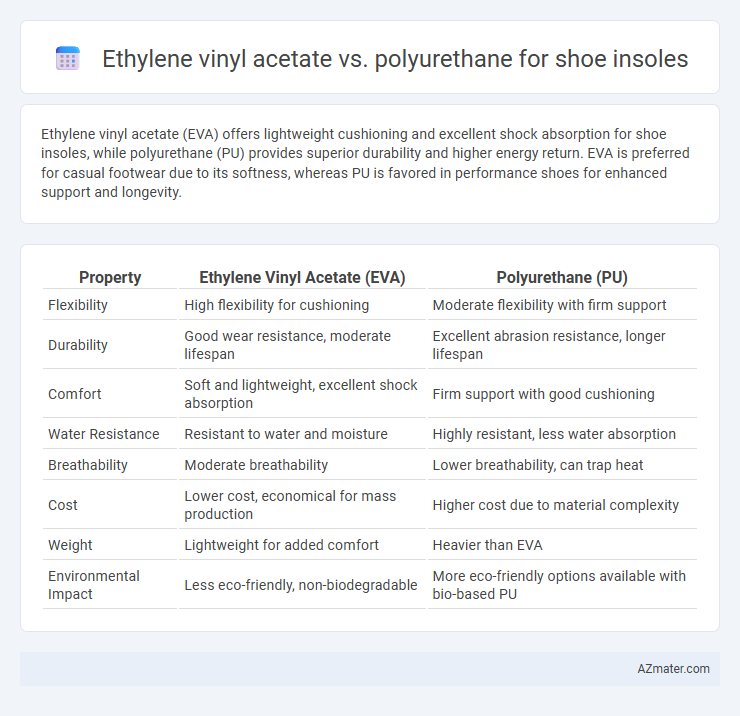Ethylene vinyl acetate (EVA) offers lightweight cushioning and excellent shock absorption for shoe insoles, while polyurethane (PU) provides superior durability and higher energy return. EVA is preferred for casual footwear due to its softness, whereas PU is favored in performance shoes for enhanced support and longevity.
Table of Comparison
| Property | Ethylene Vinyl Acetate (EVA) | Polyurethane (PU) |
|---|---|---|
| Flexibility | High flexibility for cushioning | Moderate flexibility with firm support |
| Durability | Good wear resistance, moderate lifespan | Excellent abrasion resistance, longer lifespan |
| Comfort | Soft and lightweight, excellent shock absorption | Firm support with good cushioning |
| Water Resistance | Resistant to water and moisture | Highly resistant, less water absorption |
| Breathability | Moderate breathability | Lower breathability, can trap heat |
| Cost | Lower cost, economical for mass production | Higher cost due to material complexity |
| Weight | Lightweight for added comfort | Heavier than EVA |
| Environmental Impact | Less eco-friendly, non-biodegradable | More eco-friendly options available with bio-based PU |
Introduction to Shoe Insole Materials
Ethylene vinyl acetate (EVA) and polyurethane (PU) are widely used materials for shoe insoles due to their cushioning and durability properties. EVA offers lightweight flexibility and excellent shock absorption, making it ideal for athletic and casual footwear. Polyurethane provides superior support, resilience, and longevity, often preferred in work boots and orthotic insoles for enhanced foot stability and comfort.
What is Ethylene Vinyl Acetate (EVA)?
Ethylene Vinyl Acetate (EVA) is a flexible, lightweight polymer commonly used in shoe insoles for its excellent shock absorption and cushioning properties. EVA's closed-cell structure provides buoyancy, moisture resistance, and durability, making it ideal for athletic and casual footwear. Compared to polyurethane, EVA offers better breathability and a softer feel, enhancing overall foot comfort during prolonged wear.
What is Polyurethane (PU)?
Polyurethane (PU) is a versatile polymer widely used in shoe insoles due to its excellent durability, flexibility, and cushioning properties. It provides superior shock absorption and resilience compared to Ethylene Vinyl Acetate (EVA), making it ideal for high-performance footwear. PU insoles also offer enhanced moisture resistance and long-lasting comfort, which contributes to improved foot support and overall wearability.
Cushioning and Comfort: EVA vs PU
Ethylene vinyl acetate (EVA) offers superior cushioning in shoe insoles due to its lightweight and flexible foam structure, effectively absorbing shock and reducing foot fatigue during extended wear. Polyurethane (PU) insoles provide enhanced durability and better support with a firmer feel, maintaining cushioning properties over longer periods without significant compression. For optimal comfort, EVA is preferred for softer, more adaptive cushioning, while PU excels in offering stable, long-lasting comfort in high-impact or demanding footwear environments.
Durability and Longevity Comparison
Ethylene vinyl acetate (EVA) insoles offer excellent shock absorption but tend to compress and lose cushioning over time, reducing durability. In contrast, polyurethane (PU) insoles provide superior resilience and maintain structural integrity longer, making them more durable for extended use. PU's enhanced longevity is especially beneficial in high-impact activities, supporting consistent comfort and foot protection.
Weight and Flexibility Differences
Ethylene vinyl acetate (EVA) insoles are significantly lighter than polyurethane (PU) counterparts, making them ideal for reducing overall shoe weight and enhancing comfort during prolonged wear. EVA offers superior flexibility due to its softer and more elastic nature, allowing for better shock absorption and adaptive movement with the foot. Polyurethane insoles, while more durable and supportive, tend to be denser and less flexible, which can result in a firmer feel and increased weight.
Shock Absorption Capabilities
Ethylene vinyl acetate (EVA) offers excellent shock absorption due to its lightweight, flexible, and compressible properties, making it ideal for reducing impact forces in shoe insoles. Polyurethane (PU) provides superior durability and energy return with a denser structure that maintains cushioning over prolonged use. EVA excels in short-term comfort and impact dispersion, while PU is preferred for long-lasting shock absorption and support in high-performance footwear.
Breathability and Moisture Management
Ethylene vinyl acetate (EVA) offers moderate breathability and effectively absorbs moisture, making it suitable for lightweight shoe insoles that require basic moisture management. Polyurethane (PU) excels in breathability due to its open-cell structure and provides superior moisture-wicking properties, enhancing comfort during prolonged wear. PU insoles also maintain better durability and cushioning when exposed to sweat, outperforming EVA in moisture control and air circulation.
Cost Analysis: EVA vs PU Insoles
Ethylene vinyl acetate (EVA) insoles are generally more cost-effective than polyurethane (PU) insoles due to lower raw material and production expenses, making them a popular choice for budget-friendly footwear. EVA offers lightweight cushioning and flexibility, which balances comfort with affordability, while PU insoles provide enhanced durability and support but at a higher manufacturing cost. The price difference between EVA and PU insoles can impact the overall shoe retail price, influencing consumer preference based on cost versus performance trade-offs.
Which Material is Best for Your Needs?
Ethylene vinyl acetate (EVA) offers lightweight cushioning and excellent shock absorption, making it ideal for everyday footwear and casual use, while polyurethane (PU) provides superior durability, support, and resistance to compression, suited for athletic and high-performance insoles. EVA insoles excel in flexibility and moisture resistance, benefiting users who prioritize comfort and breathability, whereas PU insoles deliver enhanced longevity and stability, crucial for those requiring maximum foot support during rigorous activities. Selecting the best material depends on your activity level, cushioning preference, and durability needs, with EVA favored for soft comfort and PU chosen for robust, long-lasting performance.

Infographic: Ethylene vinyl acetate vs Polyurethane for Shoe insole
 azmater.com
azmater.com